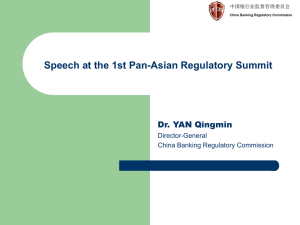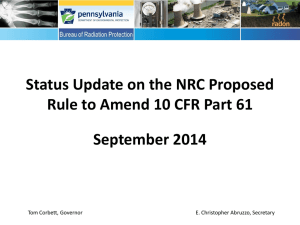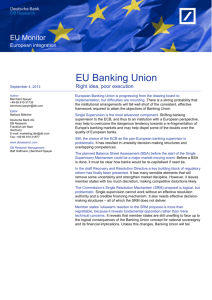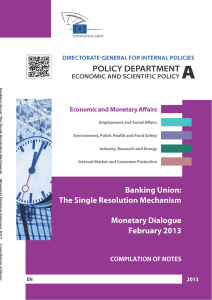Committee on Finance, Public Expenditure and Reform Discussion
advertisement
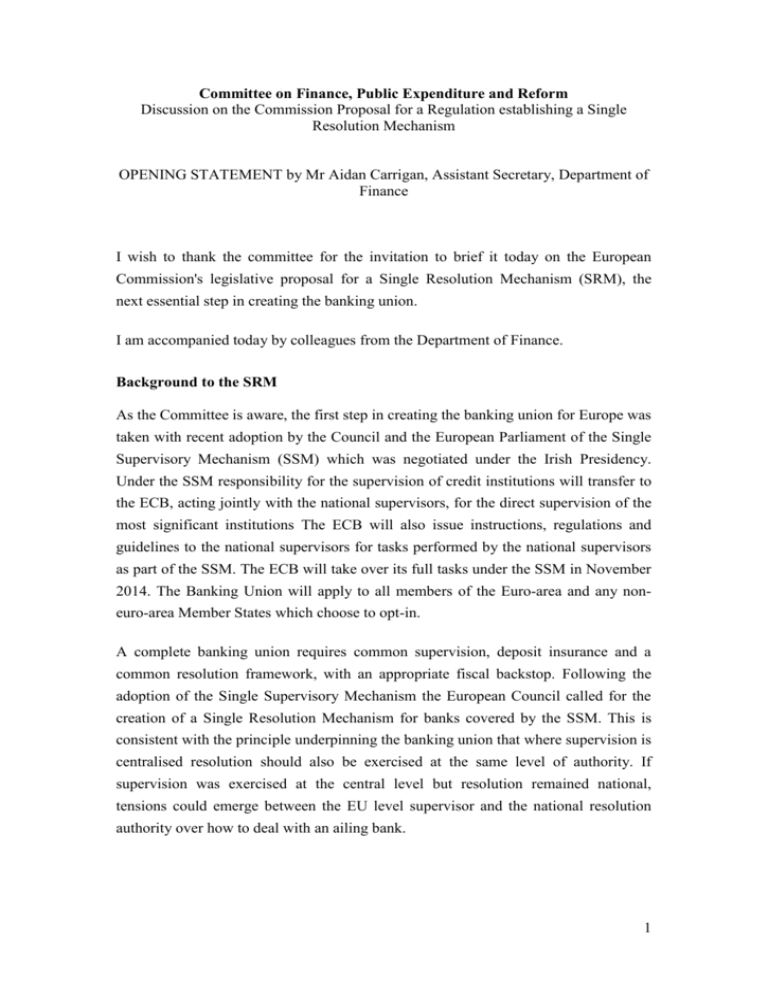
Committee on Finance, Public Expenditure and Reform Discussion on the Commission Proposal for a Regulation establishing a Single Resolution Mechanism OPENING STATEMENT by Mr Aidan Carrigan, Assistant Secretary, Department of Finance I wish to thank the committee for the invitation to brief it today on the European Commission's legislative proposal for a Single Resolution Mechanism (SRM), the next essential step in creating the banking union. I am accompanied today by colleagues from the Department of Finance. Background to the SRM As the Committee is aware, the first step in creating the banking union for Europe was taken with recent adoption by the Council and the European Parliament of the Single Supervisory Mechanism (SSM) which was negotiated under the Irish Presidency. Under the SSM responsibility for the supervision of credit institutions will transfer to the ECB, acting jointly with the national supervisors, for the direct supervision of the most significant institutions The ECB will also issue instructions, regulations and guidelines to the national supervisors for tasks performed by the national supervisors as part of the SSM. The ECB will take over its full tasks under the SSM in November 2014. The Banking Union will apply to all members of the Euro-area and any noneuro-area Member States which choose to opt-in. A complete banking union requires common supervision, deposit insurance and a common resolution framework, with an appropriate fiscal backstop. Following the adoption of the Single Supervisory Mechanism the European Council called for the creation of a Single Resolution Mechanism for banks covered by the SSM. This is consistent with the principle underpinning the banking union that where supervision is centralised resolution should also be exercised at the same level of authority. If supervision was exercised at the central level but resolution remained national, tensions could emerge between the EU level supervisor and the national resolution authority over how to deal with an ailing bank. 1 SRM proposal The SRM proposal is titled: Proposal for a regulation of the European Parliament and of the Council establishing uniform rules and a uniform procedure for the resolution of credit institutions and certain investment firms in the framework of a Single Resolution Mechanism and a Single Bank Resolution Fund and amending Regulation (EU) No 1093/2010 of the European Parliament and of the Council. The Single Resolution Mechanism consists of a Single Resolution Board and a Single Resolution Fund. Importantly, the fund will be financed by contributions from the banking sector. The Board will generally make the initial decision about whether a bank needs to be put into resolution and will draw up the necessary plans and make a determination whether funding from the Single Resolution Fund is necessary. However, without a treaty change it is not possible for an EU institution to delegate policy making powers to a subsidiary body such as the SRB. Therefore, the European Commission will take the final decision to actually trigger resolution and use the fund. The basis for implementing resolution under the SRM will be the tool-kit set out in the bank recovery and resolution directive (BRRD) which was agreed on by Member States at the June 26 ECOFIN, under the Irish Presidency. This common toolkit for resolution will help ensure a reasonably level playing field across the EU between participating Member States in the SSM/SRM, and those who have decided to remain outside of it. It should be noted that the BRRD has yet to be finalised, however trilogue negotiations are on-going with the European Parliament and it is hoped agreement can be reached by the end of the year. Why is the SRM needed ? Before proceeding to outline the main elements of the proposal I will briefly explain why it is felt that a single resolution mechanism is considered necessary in addition to the bank resolution scheme already agreed on by the ECOFIN Ministers. The purpose of the BRRD is to provide national authorities with common powers and instruments to pre-empt bank crises and to resolve any financial institution in an orderly manner in the event of failure, whilst preserving essential bank operations and minimising taxpayers' exposure to losses. These powers represent a minimum harmonisation of the rules to be used in resolution, and therefore there remains the 2 potential for variations in how Member States handle resolution. In a Banking Union context however, stakeholders generally agree that in a situation where the supervision of banks has transferred to the centre, resolution should also take place at the same level. Without such symmetry market expectations about Member States’ inability to deal with bank failures nationally could continue, reinforcing feedback loops between sovereigns and banks and fragmentation and competitive distortions across the internal market. Furthermore the Commission is of the view that a strong single resolution mechanism is critical to ensure timely and least-cost resolution of banks. They believe that the goal should be a centralised authority with power to trigger resolution and make decisions on burden sharing. Ireland welcomes the Single Resolution Mechanism as the next essential step in creating the Banking Union. The SSM is now in place and the ECB will take over the direct supervision in November of next year. Progress is being made in discussions with the European Parliament on concluding the EU Deposit Guarantee Directive. The creation of the SRM with centralised decision making by a Single Resolution Board and equipped with the resources of a Single Resolution Fund, financed by contributions from the financial sector, will in our view represent a significant step to in achieving the core objective of breaking the link between the sovereign and the banking sector. Let me now take a few moments to set out the main elements of the proposal as published by the Commission. Main elements of the proposal a) Legal basis: the SRM will be based on the Single Market Treaty Article 114 TFEU which provides for the harmonisation of laws in Member States in the pursuit of smooth functioning of the single market. The Commission's own legal services have indicated that they believe the legal basis is sound. Treaty change would be required to make the Single Resolution Board independent in its role and while there is a view that this might be preferable the time required for such a Treaty change did not fit into the timetable demanded by leaders and Heads of State for the completion of the banking union, or for that matter, by the financial markets. The Commission believes that the proposed governance structure whereby it would retain the ultimate decision making authority is consistent with the Meroni principle. This principle requires that there should be no delegation of discretionary 3 powers with a wide margin of discretion which would have the effect of transferring policy making powers b) Scope: It is proposed that the SRM will be directly responsible for the resolution of all banks in Member States participating in the Single Supervisory Mechanism (about 6000). As is regularly recalled, relatively small distressed banks have been the source of considerable systemic difficulties. The proposal does not permit a differentiated approach similar to that in the SSM (where the ECB is responsible for supervision of all banks but will only directly supervise the most significant credit institutions) as it is considered that the nature of the resolution process requires a high degree of centralisation of resolution decisionmaking so that successful bank resolution decisions can be taken rapidly. Irish credit unions are not credit institutions for the purpose of the Capital Requirements Directive and consequently are not within the scope of the SSM/SRM. c) Structure/Governance: While the Commission will make key decisions such as in relation to approval of resolution, the Single Resolution Board will prepare and carry out the resolution of any bank in a Member State participating in the Banking Union. The Board would apply the resolution toolkit as established in the bank recovery and resolution directive (BRRD). The Board would be composed of the Executive Director, the Deputy Executive Director, representatives of the Commission and the ECB, and the representatives of the resolution authorities of participating Member States. Under the proposal, the Board has two configurations: the Plenary Session of the Board involving all Member States resolution authorities and an Executive Session of the Board. The Executive Board is the key decision making forum of the SRB. Under the proposal as published, the Executive board consists of the Executive Director, the Deputy Executive Director, the representatives appointed by the Commission and the ECB, and the relevant national authorities of a credit institution subject to a resolution decision. Decisions would be by simple majority, with the home resolution authority having 1 vote whereas all of the host resolution authorities would collectively have 1 vote. Division of Competencies: the proposal makes a clear distinction between the role of the SRB and that of the national resolution authorities. The SRB, and ultimately the Commission, occupy the decision making level whereas the national resolution authorities are responsible for implementing all resolution actions decided on by the SRB/Commission. If a national resolution authority does not comply with the decision of the SRB, the SRB/Commission could directly address executive orders to the credit institution involved. 4 d) Triggering Resolution: In practice it is expected that the ECB as supervisor will indicate to the SRB that a credit institution in a SSM participating Member State is in severe financial difficulties and that it should be resolved. The executive board of the SRB would prepare the resolution of the bank including which resolution tools to use and how the single European resolution fund should be involved. The proposal provides that the European Commission acting on the recommendation of the SRB, or “on its own initiative” can decide whether to place the credit institution under resolution. The national resolution authority would be responsible for implementing the decisions of the Commission and or Board. e) Funding: The Commission proposes a Single Resolution Fund to be set up to be available for funding support for a credit institution in resolution. The fund would be built up over 10 years through contributions from the banking sector. It will replace the national resolution funds of participating Member States. The target level of the fund is 1% of covered deposits of SSM credit institutions which equates to €55bn€60bn. The SRM is constructed with the objective that resolution is carried out without recourse to national taxpayers’ money. Instead banks themselves would contribute to the costs of resolution though the collection of levies, and where the fund is not sufficient through ex-post levies. Under the proposal, the Fund can “seek borrowings or other forms of support” from … other third parties”. The SRF could also seek market based funding. Until the SRF reaches its target funding level provision is made for the Member State representative of the Executive Board to delay but not prevent resolution decisions where it impinges on national fiscal responsibilities. This is a very sensitive issue for a number of Member States and there has been much debate in the Council negotiations on the SRM on an EU backstop which would guarantee a line of credit to the SRF in such shortfall situations. Any money advanced by such a backstop would have to be repaid by the banking sector through monies raised by the levy process. The Ad-Hoc Working Party In view of the high importance and complexity of this proposal a high-level ad-hoc working group (AHWP) of officials and experts from each Member State was established. The AHWP has met seven times in order to make progress on this file and has discussed various options for a possible overall compromise. As a result of these debates, the Council Presidency has drafted three compromise texts and is of the view that the third text, to the extent possible, addresses the main concerns raised by the Member States. This text will be debated by the ECOFIN Council at the meeting on 15 November. 5 While negotiations continue and agreement has yet to be reached on all aspects of the proposal, Lithuania, the current Council Presidency is prioritising the SRM proposal . The October European Council called for agreement among Member States by the end of the year to allow for the negotiations with the EP and for the co-legislators to reach agreement on the proposal within the current legislative term. Given that European Parliament elections are scheduled for the end of May 2014, this effectively requires agreement between the co-decision authorities by end of March 2014. Conclusion As I have already stated, Ireland fully supports the creation of the SRM as a significant and essential step in creating a credible banking union for Europe. We consider that the Commission proposal provides a strong basis for an effective Single Resolution Mechanism supported by an industry funded single resolution fund. I am happy to take any questions or provide any clarifications to assist the Committee. Thank you. 6

